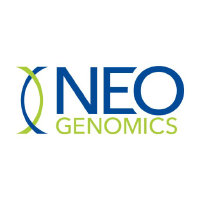
Neogenomics Inc
NASDAQ:NEO


| US |

|
Johnson & Johnson
NYSE:JNJ
|
Pharmaceuticals
|
| US |

|
Berkshire Hathaway Inc
NYSE:BRK.A
|
Financial Services
|
| US |

|
Bank of America Corp
NYSE:BAC
|
Banking
|
| US |

|
Mastercard Inc
NYSE:MA
|
Technology
|
| US |

|
UnitedHealth Group Inc
NYSE:UNH
|
Health Care
|
| US |

|
Exxon Mobil Corp
NYSE:XOM
|
Energy
|
| US |

|
Pfizer Inc
NYSE:PFE
|
Pharmaceuticals
|
| US |

|
Palantir Technologies Inc
NYSE:PLTR
|
Technology
|
| US |

|
Nike Inc
NYSE:NKE
|
Textiles, Apparel & Luxury Goods
|
| US |

|
Visa Inc
NYSE:V
|
Technology
|
| CN |

|
Alibaba Group Holding Ltd
NYSE:BABA
|
Retail
|
| US |

|
3M Co
NYSE:MMM
|
Industrial Conglomerates
|
| US |

|
JPMorgan Chase & Co
NYSE:JPM
|
Banking
|
| US |

|
Coca-Cola Co
NYSE:KO
|
Beverages
|
| US |

|
Walmart Inc
NYSE:WMT
|
Retail
|
| US |

|
Verizon Communications Inc
NYSE:VZ
|
Telecommunication
|
Utilize notes to systematically review your investment decisions. By reflecting on past outcomes, you can discern effective strategies and identify those that underperformed. This continuous feedback loop enables you to adapt and refine your approach, optimizing for future success.
Each note serves as a learning point, offering insights into your decision-making processes. Over time, you'll accumulate a personalized database of knowledge, enhancing your ability to make informed decisions quickly and effectively.
With a comprehensive record of your investment history at your fingertips, you can compare current opportunities against past experiences. This not only bolsters your confidence but also ensures that each decision is grounded in a well-documented rationale.
Do you really want to delete this note?
This action cannot be undone.

| 52 Week Range |
13
20.59
|
| Price Target |
|
We'll email you a reminder when the closing price reaches USD.
Choose the stock you wish to monitor with a price alert.

|
Johnson & Johnson
NYSE:JNJ
|
US |

|
Berkshire Hathaway Inc
NYSE:BRK.A
|
US |

|
Bank of America Corp
NYSE:BAC
|
US |

|
Mastercard Inc
NYSE:MA
|
US |

|
UnitedHealth Group Inc
NYSE:UNH
|
US |

|
Exxon Mobil Corp
NYSE:XOM
|
US |

|
Pfizer Inc
NYSE:PFE
|
US |

|
Palantir Technologies Inc
NYSE:PLTR
|
US |

|
Nike Inc
NYSE:NKE
|
US |

|
Visa Inc
NYSE:V
|
US |

|
Alibaba Group Holding Ltd
NYSE:BABA
|
CN |

|
3M Co
NYSE:MMM
|
US |

|
JPMorgan Chase & Co
NYSE:JPM
|
US |

|
Coca-Cola Co
NYSE:KO
|
US |

|
Walmart Inc
NYSE:WMT
|
US |

|
Verizon Communications Inc
NYSE:VZ
|
US |
This alert will be permanently deleted.
 Neogenomics Inc
Neogenomics Inc
Neogenomics Inc
Investor Relations
NeoGenomics Inc. stands as a formidable player in the field of cancer diagnostics, carving out a niche where precision and innovation meet the urgent needs of patients and healthcare providers. Born out of the vision to advance cancer diagnostics through a blend of clinical testing and state-of-the-art technology, NeoGenomics offers oncologists and pathologists an extensive menu of tests that target genetic markers critical for cancer diagnosis and monitoring. The company operates through a network of high-complexity laboratories in the United States and a growing presence internationally, leveraging its vast technological capabilities to provide services like cytogenetics, molecular testing, and solid tumor testing. This breadth of service allows NeoGenomics to sit squarely at the intersection of patient care and the burgeoning field of personalized medicine.
By anchoring its revenue streams primarily in laboratory services, NeoGenomics draws its financial strength from a diverse clientele of community-based healthcare providers, academic institutions, and pharmaceutical companies. The firm capitalizes on the demand for precision diagnostics, as more treatments necessitate an intimate understanding of the tumor’s genetic makeup. This careful calibration between cutting-edge science and clinical practice not only fuels its growth but also positions NeoGenomics as an indispensable partner in the continuum of cancer care. Additionally, its collaborations with pharmaceutical companies open doors to new revenue channels via companion diagnostic development and clinical trial support services, exemplifying an agile approach in the dynamic landscape of oncology.

NeoGenomics Inc. stands as a formidable player in the field of cancer diagnostics, carving out a niche where precision and innovation meet the urgent needs of patients and healthcare providers. Born out of the vision to advance cancer diagnostics through a blend of clinical testing and state-of-the-art technology, NeoGenomics offers oncologists and pathologists an extensive menu of tests that target genetic markers critical for cancer diagnosis and monitoring. The company operates through a network of high-complexity laboratories in the United States and a growing presence internationally, leveraging its vast technological capabilities to provide services like cytogenetics, molecular testing, and solid tumor testing. This breadth of service allows NeoGenomics to sit squarely at the intersection of patient care and the burgeoning field of personalized medicine.
By anchoring its revenue streams primarily in laboratory services, NeoGenomics draws its financial strength from a diverse clientele of community-based healthcare providers, academic institutions, and pharmaceutical companies. The firm capitalizes on the demand for precision diagnostics, as more treatments necessitate an intimate understanding of the tumor’s genetic makeup. This careful calibration between cutting-edge science and clinical practice not only fuels its growth but also positions NeoGenomics as an indispensable partner in the continuum of cancer care. Additionally, its collaborations with pharmaceutical companies open doors to new revenue channels via companion diagnostic development and clinical trial support services, exemplifying an agile approach in the dynamic landscape of oncology.





























 You don't have any saved screeners yet
You don't have any saved screeners yet
